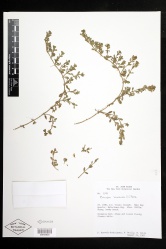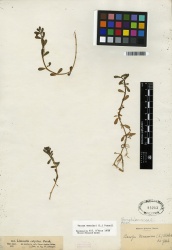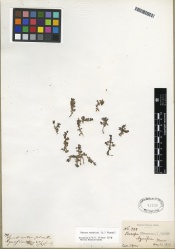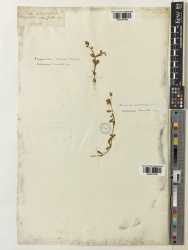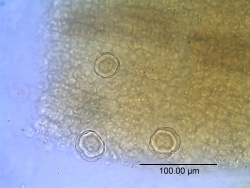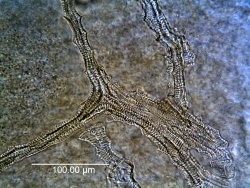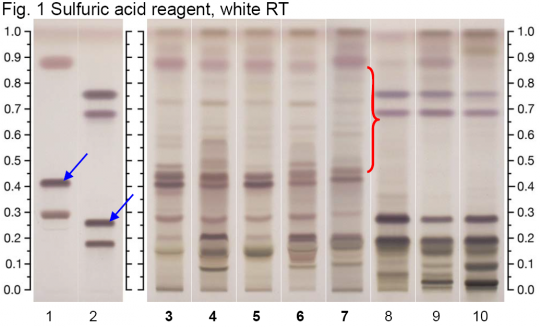Bacopa monnieri (whole plant)
Contents |
Nomenclature
Bacopa monnieri (L.) Pennell Scrophulariaceae
Syn. Herpestis monniera (L.) Kunth
Standardized common name (English): bacopa
Ayurvedic name(s): brahmi; mandukaparni
Botanical Voucher Specimen
|
|
|
 |
||
|
|
|
|
Organoleptic Characteristics
|
Macroscopic Characteristics
|
Microscopic Characteristics
|
 |
 |
|
|
|
High Performance Thin Layer Chromatographic Identification
|
Bacopa (leaf) (Bacopa monnieri) Lane Assignments Lanes, from left to right (Track, Volume, Sample):
Reference Sample(s) Reference: Individually dissolve 1 mg of bacoside A3 and 1 mg of asiaticoside in 1 mL of methanol. Optional: Individually dissolve 1 mg each of asiatic acid, madecassic acid, madecassoside, bacopaside, and bacosine in 1 mL of methanol. Stationary Phase Stationary phase, i.e. Silica gel 60, F254 Mobile Phase Dichloromethane, methanol, water 14:6:1 (v/v/v) Sample Preparation Method Sample: Mix 1.0 g of powdered sample with 10 mL of methanol and sonicate for 10 minutes, then centrifuge or filter the solutions and use the supernatants / filtrates as test solutions. Derivatization reagent: Sulfuric acid reagent; Preparation: 20 mL of sulfuric acid 98% in 180 mL of methanol. Use: Dip (time 0, speed 5), heat at 120°C for 3 min. Detection Method Saturated chamber; developing distance 70 mm from lower edge; relative humidity 33% Other Notes Images presented in this entry are examples and are not intended to be used as a bases for setting specifications for quality control purposes. System suitability test: Bacoside A3: brownish violet zone at Rf ~ 0.48. Asiaticoside: brownish violet zone at Rf ~ 0.30. Identification: Compare result with reference images. The fingerprint of the test solution is similar to that of the corresponding botanical reference sample. Additional weak zones may be present. Under white light the test solution shows a brown zone at the position of reference bacoside A3 and a faint pink zone at the position of reference bacoside at Rf ~ 0.90. In the lower third of the chromatogram there may be several greenish-brown zones. Test for adulteration: No intense zones may be seen between the zone due to bacoside A3 and bacosine (red arrow, Gotu kola herb).
|
Supplementary Information
Sources
- ↑ Images courtesy of the C.V. Starr Virtual Herbarium of the New York Botanical Garden http://sciweb.nybg.org/science2/VirtualHerbarium.asp
- ↑ Images courtesy of the C.V. Starr Virtual Herbarium of the New York Botanical Garden http://sciweb.nybg.org/science2/VirtualHerbarium.asp
- ↑ MOBOT, Tropicos.org http://www.tropicos.org/Image/100184367
- ↑ MOBOT, Tropicos.org http://www.tropicos.org/Image/100141911
- ↑ Royal Botanic Gardens, Kew. http://specimens.kew.org/herbarium/K000979487
- ↑ Natural Remedies Pvt Ltd http://www.naturalremedy.com/
- ↑ Natural Remedies Pvt Ltd http://www.naturalremedy.com/
- ↑ Natural Remedies Pvt Ltd http://www.naturalremedy.com/
- ↑ Natural Remedies Pvt Ltd http://www.naturalremedy.com/
- ↑ Elan M. Sudberg, Alkemist Laboratories http://www.alkemist.com
- ↑ Elan M. Sudberg, Alkemist Laboratories http://www.alkemist.com
- ↑ HPTLC Association http://www.hptlc-association.org/

